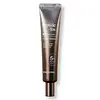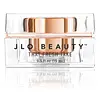What's inside
What's inside
 Key Ingredients
Key Ingredients

 Benefits
Benefits

 Concerns
Concerns

 Ingredients Side-by-side
Ingredients Side-by-side

Water
Skin ConditioningButylene Glycol
HumectantCaprylic/Capric Triglyceride
MaskingGlycerin
HumectantCetyl Alcohol
EmollientPolyglyceryl-3 Methylglucose Distearate
EmulsifyingPalmitic Acid
EmollientStearic Acid
CleansingUrea
BufferingCyclopentasiloxane
EmollientStearyl Alcohol
EmollientC12-15 Alkyl Benzoate
AntimicrobialGlyceryl Stearate
EmollientCarbomer
Emulsion StabilisingTriethanolamine
BufferingMyristyl Alcohol
EmollientDimethicone
EmollientBetaine
HumectantPropanediol
SolventLimnanthes Alba Seed Oil
Skin ConditioningMacadamia Ternifolia Seed Oil
EmollientLauryl Alcohol
EmollientEthylhexylglycerin
Skin ConditioningPanthenol
Skin ConditioningPvp
Emulsion StabilisingAdenosine
Skin ConditioningDisodium EDTA
Arachidic Acid
CleansingSodium Hyaluronate
HumectantAloe Barbadensis Leaf Juice
Skin ConditioningScutellaria Baicalensis Root Extract
AstringentLauric Acid
CleansingMyristic Acid
CleansingOleic Acid
EmollientRosmarinus Officinalis Leaf Extract
AntimicrobialAloe Barbadensis Leaf Extract
EmollientCamellia Sinensis Leaf Extract
AntimicrobialLavandula Angustifolia Extract
Skin ConditioningBioflavonoids
Skin ConditioningCitric Acid
BufferingBrassica Oleracea Italica Extract
AstringentPalmitoyl Tetrapeptide-7
Skin ConditioningAcetyl Hexapeptide-8
HumectantHydrolyzed Collagen
EmollientPalmitoyl Tripeptide-1
Skin ConditioningSh-Oligopeptide-1
Skin ConditioningSh-Oligopeptide-2
Skin ConditioningSh-Polypeptide-1
Skin ConditioningSh-Polypeptide-16
Skin ProtectingSh-Polypeptide-3
Skin ConditioningHydroxyacetophenone
Antioxidant1,2-Hexanediol
Skin ConditioningCaprylyl Glycol
EmollientSodium Benzoate
MaskingPotassium Sorbate
PreservativePhenoxyethanol
PreservativeWater, Butylene Glycol, Caprylic/Capric Triglyceride, Glycerin, Cetyl Alcohol, Polyglyceryl-3 Methylglucose Distearate, Palmitic Acid, Stearic Acid, Urea, Cyclopentasiloxane, Stearyl Alcohol, C12-15 Alkyl Benzoate, Glyceryl Stearate, Carbomer, Triethanolamine, Myristyl Alcohol, Dimethicone, Betaine, Propanediol, Limnanthes Alba Seed Oil, Macadamia Ternifolia Seed Oil, Lauryl Alcohol, Ethylhexylglycerin, Panthenol, Pvp, Adenosine, Disodium EDTA, Arachidic Acid, Sodium Hyaluronate, Aloe Barbadensis Leaf Juice, Scutellaria Baicalensis Root Extract, Lauric Acid, Myristic Acid, Oleic Acid, Rosmarinus Officinalis Leaf Extract, Aloe Barbadensis Leaf Extract, Camellia Sinensis Leaf Extract, Lavandula Angustifolia Extract, Bioflavonoids, Citric Acid, Brassica Oleracea Italica Extract, Palmitoyl Tetrapeptide-7, Acetyl Hexapeptide-8, Hydrolyzed Collagen, Palmitoyl Tripeptide-1, Sh-Oligopeptide-1, Sh-Oligopeptide-2, Sh-Polypeptide-1, Sh-Polypeptide-16, Sh-Polypeptide-3, Hydroxyacetophenone, 1,2-Hexanediol, Caprylyl Glycol, Sodium Benzoate, Potassium Sorbate, Phenoxyethanol
Water
Skin ConditioningCyclopentasiloxane
EmollientDimethicone
EmollientAdipic Acid/Neopentyl Glycol Crosspolymer
Pentaerythrityl Tetracaprylate/Tetracaprate
EmollientCetyl Alcohol
EmollientDimethicone Crosspolymer
Emulsion StabilisingHydrogenated Coco-Glycerides
EmollientPEG-100 Stearate
Glyceryl Stearate
EmollientGlycerin
HumectantCyclohexasiloxane
EmollientTocopherol
AntioxidantAlpha-Glucan Oligosaccharide
CleansingOlea Europaea Leaf Extract
PerfumingGalactomyces Ferment Filtrate
HumectantBenzyl Alcohol
PerfumingPropanediol
SolventPolyurethane-35
Stearic Acid
CleansingPEG-75 Stearate
1,2-Hexanediol
Skin ConditioningVp/Va Copolymer
Ceteth-20
CleansingSteareth-20
CleansingAmodimethicone
Biosaccharide Gum-4
Skin ConditioningHydroxypropyl Methylcellulose
Emulsion StabilisingEthylhexylglycerin
Skin ConditioningCarnosine
Skin ConditioningCaffeine
Skin ConditioningAlgin
MaskingDisodium EDTA
Citric Acid
BufferingXanthan Gum
EmulsifyingLecithin
EmollientHeptapeptide-7
Skin ConditioningSodium Hyaluronate
HumectantCaprylyl Glycol
EmollientPhenoxyethanol
PreservativePotassium Sorbate
PreservativeSodium Benzoate
MaskingWater, Cyclopentasiloxane, Dimethicone, Adipic Acid/Neopentyl Glycol Crosspolymer, Pentaerythrityl Tetracaprylate/Tetracaprate, Cetyl Alcohol, Dimethicone Crosspolymer, Hydrogenated Coco-Glycerides, PEG-100 Stearate, Glyceryl Stearate, Glycerin, Cyclohexasiloxane, Tocopherol, Alpha-Glucan Oligosaccharide, Olea Europaea Leaf Extract, Galactomyces Ferment Filtrate, Benzyl Alcohol, Propanediol, Polyurethane-35, Stearic Acid, PEG-75 Stearate, 1,2-Hexanediol, Vp/Va Copolymer, Ceteth-20, Steareth-20, Amodimethicone, Biosaccharide Gum-4, Hydroxypropyl Methylcellulose, Ethylhexylglycerin, Carnosine, Caffeine, Algin, Disodium EDTA, Citric Acid, Xanthan Gum, Lecithin, Heptapeptide-7, Sodium Hyaluronate, Caprylyl Glycol, Phenoxyethanol, Potassium Sorbate, Sodium Benzoate
Ingredients Explained
These ingredients are found in both products.
Ingredients higher up in an ingredient list are typically present in a larger amount.
1,2-Hexanediol is a synthetic liquid and another multi-functional powerhouse.
It is a:
- Humectant, drawing moisture into the skin
- Emollient, helping to soften skin
- Solvent, dispersing and stabilizing formulas
- Preservative booster, enhancing the antimicrobial activity of other preservatives
Caprylyl Glycol is a humectant and emollient, meaning it attracts and preserves moisture.
It is a common ingredient in many products, especially those designed to hydrate skin. The primary benefits are retaining moisture, skin softening, and promoting a healthy skin barrier.
Though Caprylyl Glycol is an alcohol derived from fatty acids, it is not the kind that can dry out skin.
This ingredient is also used as a preservative to extend the life of products. It has slight antimicrobial properties.
Learn more about Caprylyl GlycolCetyl Alcohol is a fatty alcohol. Fatty Alcohols are most often used as an emollient or to thicken a product.
Its main roles are:
Though it has "alcohol" in the name, it is not related to denatured alcohol or ethyl alcohol.
The FDA allows products labeled "alcohol-free" to have fatty alcohols.
Learn more about Cetyl AlcoholCitric Acid is an alpha hydroxy acid (AHA) naturally found in citrus fruits like oranges, lemons, and limes.
Like other AHAs, citric acid can exfoliate skin by breaking down the bonds that hold dead skin cells together. This helps reveal smoother and brighter skin underneath.
However, this exfoliating effect only happens at high concentrations (20%) which can be hard to find in cosmetic products.
Due to this, citric acid is usually included in small amounts as a pH adjuster. This helps keep products slightly more acidic and compatible with skin's natural pH.
In skincare formulas, citric acid can:
While it can provide some skin benefits, research shows lactic acid and glycolic acid are generally more effective and less irritating exfoliants.
Most citric acid used in skincare today is made by fermenting sugars (usually from molasses). This synthetic version is identical to the natural citrus form but easier to stabilize and use in formulations.
Read more about some other popular AHA's here:
Learn more about Citric AcidCyclopentasiloxane, or D5, is a silicone used to improve texture of products and trap moisture.
D5 is considered lightweight and volatile. Volatile means it evaporates quickly after application. Once evaporated, D5 leaves a thin barrier that helps keep skin hydrated.
It is also an emollient. Emollients help soften the skin and prevent water loss. Silicones create a silky texture in products. D5 helps other ingredients become more spreadable.
Studies show D5 is safe to use in skincare products. We recommend speaking with a skincare professional if you have concerns.
Learn more about CyclopentasiloxaneDimethicone is a type of synthetic silicone created from natural materials such as quartz.
What it does:
Dimethicone comes in different viscosities:
Depending on the viscosity, dimethicone has different properties.
Ingredients lists don't always show which type is used, so we recommend reaching out to the brand if you have questions about the viscosity.
This ingredient is unlikely to cause irritation because it does not get absorbed into skin. However, people with silicone allergies should be careful about using this ingredient.
Note: Dimethicone may contribute to pilling. This is because it is not oil or water soluble, so pilling may occur when layered with products. When mixed with heavy oils in a formula, the outcome is also quite greasy.
Learn more about DimethiconeDisodium EDTA plays a role in making products more stable by aiding other preservatives.
It is a chelating agent, meaning it neutralizes metal ions that may be found in a product.
Disodium EDTA is a salt of edetic acid and is found to be safe in cosmetic ingredients.
Learn more about Disodium EDTAEthylhexylglycerin (we can't pronounce this either) is commonly used as a preservative and skin softener. It is derived from glyceryl.
You might see Ethylhexylglycerin often paired with other preservatives such as phenoxyethanol. Ethylhexylglycerin has been found to increase the effectiveness of these other preservatives.
Glycerin is already naturally found in your skin. It helps moisturize and protect your skin.
A study from 2016 found glycerin to be more effective as a humectant than AHAs and hyaluronic acid.
As a humectant, it helps the skin stay hydrated by pulling moisture to your skin. The low molecular weight of glycerin allows it to pull moisture into the deeper layers of your skin.
Hydrated skin improves your skin barrier; Your skin barrier helps protect against irritants and bacteria.
Glycerin has also been found to have antimicrobial and antiviral properties. Due to these properties, glycerin is often used in wound and burn treatments.
In cosmetics, glycerin is usually derived from plants such as soybean or palm. However, it can also be sourced from animals, such as tallow or animal fat.
This ingredient is organic, colorless, odorless, and non-toxic.
Glycerin is the name for this ingredient in American English. British English uses Glycerol/Glycerine.
Learn more about GlycerinGlyceryl Stearate is a mix of glycerin and stearic acid.
It is used to stabilize the mixing of water and oil ingredients. By preventing these ingredients from separating, it can help elongate shelf life. It can also help thicken the product's texture.
As an emollient, it helps soften skin and supports barrier-replenishing ingredients.
In cosmetics, Glyceryl Stearate is often made from vegetable oils or synthetically produced.
This ingredient may not be fungal-acne safe
Fun fact: The human body also creates Glyceryl Stearate naturally.
Learn more about Glyceryl StearatePhenoxyethanol is a preservative that has germicide, antimicrobial, and aromatic properties. Studies show that phenoxyethanol can prevent microbial growth. By itself, it has a scent that is similar to that of a rose.
It's often used in formulations along with Caprylyl Glycol to preserve the shelf life of products.
Potassium Sorbate is a preservative used to prevent yeast and mold in products. It is commonly found in both cosmetic and food products.
This ingredient comes from potassium salt derived from sorbic acid. Sorbic acid is a natural antibiotic and effective against fungus.
Both potassium sorbate and sorbic acid can be found in baked goods, cheeses, dried meats, dried fruit, ice cream, pickles, wine, yogurt, and more.
You'll often find this ingredient used with other preservatives.
Learn more about Potassium SorbatePropanediol is an all-star ingredient. It softens, hydrates, and smooths the skin.
It’s often used to:
Propanediol is not likely to cause sensitivity and considered safe to use. It is derived from corn or petroleum with a clear color and no scent.
Learn more about PropanediolSodium Benzoate is a preservative. It's used in both cosmetic and food products to inhibit the growth of mold and bacteria. It is typically produced synthetically.
Both the US FDA and EU Health Committee have approved the use of sodium benzoate. In the US, levels of 0.1% (of the total product) are allowed.
Sodium benzoate works as a preservative by inhibiting the growth of bacteria inside of cells. It prevents the cell from fermenting a type of sugar using an enzyme called phosphofructokinase.
It is the salt of benzoic acid. Foods containing sodium benzoate include soda, salad dressings, condiments, fruit juices, wines, and snack foods.
Studies for using ascorbic acid and sodium benzoate in cosmetics are lacking, especially in skincare routines with multiple steps.
We always recommend speaking with a professional, such as a dermatologist, if you have any concerns.
Learn more about Sodium BenzoateSodium Hyaluronate is hyaluronic acid's salt form. It is commonly derived from the sodium salt of hyaluronic acid.
Like hyaluronic acid, it is great at holding water and acts as a humectant. This makes it a great skin hydrating ingredient.
Sodium Hyaluronate is naturally occurring in our bodies and is mostly found in eye fluid and joints.
These are some other common types of Hyaluronic Acid:
Learn more about Sodium HyaluronateStearic Acid is a fatty acid. It is an emollient, emulsifier, and texture enhancer.
As an emollient, stearic acid helps soften skin. It aids the skin's protective barrier by preventing water loss. It also provides a gentle cleansing effect without stripping away natural oils.
Stearic acid may also be used to enhance the texture of products. It can add volume and stabilize ingredients such as water and oil. This can help water and oil ingredients from separating.
Sources of stearic acid include animal or vegetable fats/oils such as coconut or shea. It can be naturally found in butter, cocoa butter, shea butter, vegetable fats, and animal tallow.
This ingredient may not be Malassezia folliculitis, or fungal-acne safe.
Learn more about Stearic AcidWater. It's the most common cosmetic ingredient of all. You'll usually see it at the top of ingredient lists, meaning that it makes up the largest part of the product.
So why is it so popular? Water most often acts as a solvent - this means that it helps dissolve other ingredients into the formulation.
You'll also recognize water as that liquid we all need to stay alive. If you see this, drink a glass of water. Stay hydrated!
Learn more about Water